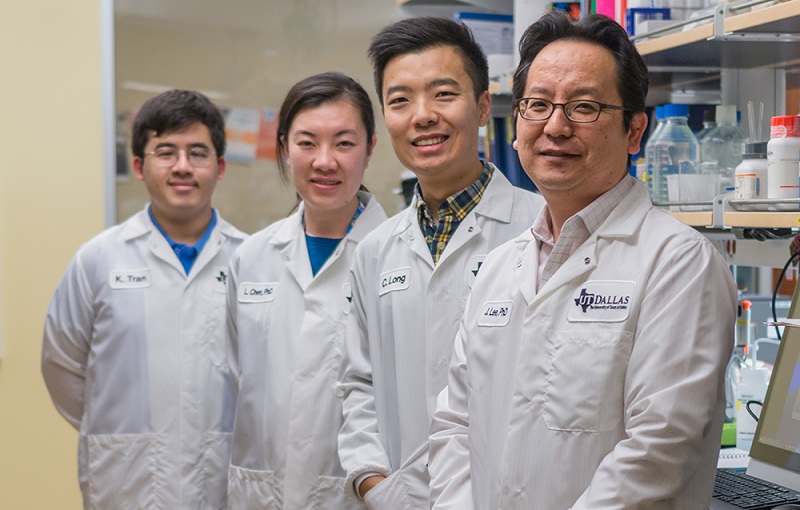Researchers Paint Bullseye on Target to Stop Tumor Metastasis
Summary: In a medical first, UT Dallas researchers just found a way to paint a bullseye target on cancer stem cells, the source of tumor metastases which spread through the body to cause 90% of all cancer deaths. [This article first appeared on LongevityFacts. Author: Brady Hartman. ]
Researchers with the University of Texas at Dallas just found a way to isolate and tag cancer stem cells, the chief culprit involved in cancer spreading to other parts of the body – the cause of 90% of all cancer deaths.
While they haven’t developed drugs that eliminate these aggressive cancer cells, they can paint a bright bullseye on their elusive target, making it easier to kill cancer stem cells.
The team announcing the finding is headed up by Jiyong Lee, Ph.D., an assistant professor in the Department of Chemistry and Biochemistry at UT Dallas. The researchers published their results in the European journal Chemistry.
University Scientists Isolate Cancer Stem Cells. Video courtesy of UT Dallas.
The main reason that cancer is so deadly is its ability to spread in the body. Most treatments that decimate a primary tumor still leave cancer stem cells unharmed. After successful treatment of a primary tumor, cancer stem cells often travel unnoticed through the bloodstream to seed new tumors elsewhere, a deadly phenomenon known as metastasis. As Dr. Lee puts it,
“There is a small population of cancer cells that is much more aggressive than others — cancer stem cells,” adding “These give rise to secondary tumors, even after the primary tumor has been successfully treated. The cells are notoriously difficult to find, let alone eradicate.”

Metastatic Cancer Lies in Wait
Once cancer spreads, it can be hard to control. Metastatic cancer cells can also remain inactive at their new location for many years before they begin to grow again. Most forms of metastatic cancer, also known as stage IV cancer, cannot be cured. As Dr. Lee says,
“Our lab is interested in finding ways to prevent cancer recurrence.” adding, “The problem is, not all cancer cells are equal.”
Searching for Sticky Compounds
The researchers set out to find compounds that would attach only to cancer stem cells and not standard cancer cells. Dr. Lee’s team used a two-step process to sort through a library of 40,000 molecules, looking for any that would selectively bind to breast cancer stem cells. The team identified five compounds that bind specifically to cancer stem cells, called ligands, and selected one of them for closer study.
While other researchers have used similar methods to separate cancer cells from non-cancerous ones, Dr. Lee said the results mark the first time a team has isolated cancer stem cells from standard cancer cells. As Lee says,
“We have approached this problem in a novel way, and for the first time have isolated a ligand that binds specifically to cancer stem cells.”
The Menace of Cancer Stem Cells
Stem cells could be considered the saints of our body because they can perform ‘miracles’ by transforming into any type of cell to rejuvenate damaged tissues.
If stem cells are saints, then cancer stem cells are the devils.
Like ordinary stem cells, cancer stem cells are not specialized and able to live forever until they transform into new cancer cells. What makes them particularly deadly is that they can convert into any other type of cancerous tissue, including tumors of the bone, liver, and lung.
Scientists believe that cancer stem cells reside at the heart of secondary tumors, fueling their growth. Such secondary tumors can appear years later and are often more aggressive and not usually treatable.
Are Cancer Stem Cells the Solution?
Many researchers believe that killing cancer stem cells should eliminate the primary tumor by removing its renewable source of cancer cells. More importantly, their eradication should also prevent the growth of secondary tumors.
Scientists have yet to test this theory because, up until now, doctors have had a difficult time isolating cancer stem cells. Dr. Lee says there are no drugs targeting cancer stem cells because you have to find them before you can kill them. As Lee puts it,
“Research in this field has been difficult because specifically targeting cancer stem cells has been hard,” adding, “There are limited methods for even detecting these cells.”
Dr. Lee hopes to use the newly identified ligands as the search part of a search and destroy mission aimed at cancer stem cells. As Lee envisions it,
“The simplest version of a therapeutic would be attaching a toxic agent to the ligand, which would then bind selectively to and kill cancer stem cells,”
Moreover, the ligands could be used to identify the cancer stem cells for further treatment. As Lee says,
“It would also be beneficial to adapt these ligands into imaging agents, which would light up the cancer stem cells in a patient and help determine the best treatment options.”
Bottom Line
While Dr. Lee’s discovery is still in its early stages, the ligand holds promise for the field of targeted cancer therapies. Because the eventual solution would be in the form of a compound, it would be less expensive to manufacture than precision cancer treatments, which require targeting to a specific genetic mutation, and certainly less costly than cancer immunotherapies, such as CAR T-cell therapy.
Like this Article?
- Help us spread the word – Please click on any social media link to share this article.
- Follow us on social media – Google+ or Reddit.
References
Cover Photo: wildpixel / Getty Images (adapted)
“University Scientists Isolate Cancer Stem Cells Using Novel Method.” The University of Texas at Dallas. Feb. 22, 2018. UT Dallas News Center.
Disclaimer
Diagnosis, Treatment, and Advice: This news article is intended for informational and educational purposes only and is not a substitute for qualified, professional medical advice. The information and opinions stated herein should not be used during any medical emergency or for the diagnosis or treatment of any medical condition. Consult a qualified and licensed physician for the diagnosis and treatment of any and all medical conditions. Experimental cancer treatments carry a much higher risk than FDA-approved ones. Dial 9-1-1, or an equivalent emergency hotline number, for all medical emergencies. As well, consult a licensed, qualified physician before changing your exercise, diet, or vitamin supplement programs. Photos, Endorsements, & External Links: This article is not intended to endorse organizations, companies, or their products. Links to external websites, mention or depiction of company names or brands, are intended for illustration only and do not constitute endorsements.
